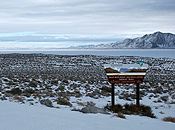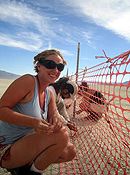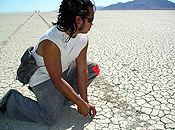In an atmosphere of awe and respect, each year the Department of Public Works (DPW) revisits the vacuum of the Nevada high desert with a circus train of a city locked and loaded into the chambers ready to be shot out onto the playa. The feeling is equally as awesome to reduce it all to nothing more than a dream less than 3 months later. This is the satisfaction of the setup and tear down of Black Rock City, located on the Black Rock Desert in northwestern Nevada. This whirlwind project encompasses massive construction and playa restoration techniques and spans the entire year, with work weekends through the winter and spring and full production through the summer from July to October. This achievement requires the collective efforts of a solid management staff and a crew of skilled labor and volunteers of about a hundred and twenty. They have committed their summer to mastering challenging workloads in the extreme conditions of the remote high desert within a very short window of time. The job leaves little room for any setbacks.
And, of course, as the city grows and matures, so do the challenges and successes. The goal of moving a project of this magnitude smoothly and efficiently forward is forever a moving target requiring spontaneity and inventive intuition.
Every year DPW welcomes this challenge.
Roster
 Streamlining and fine-tuning the many moving parts and systems that accomplish creation of the Man’s summer city require an ever-improving professional caliber of the crew. Coming from a history where the challenge was to attract anyone out to the harsh desert at all, DPW has made a steady climb over the years to create a professional and safe working environment. This objective is being achieved by creating a management council, building a solid middle management team, and opening a flourishing conduit for fresh volunteers and skilled labor. The Burning Man event in general has always been a largely volunteer-based operation, and DPW has been moving toward this concept. Surmounting issues such as housing and feeding the crew, then providing a pleasant and congenial living atmosphere, works wonders in improving overall morale, which in turn keeps production an enthusiastic and smooth sequence — always an acute challenge for the department. Strengthening relations with local neighbors allowed for workable accommodations in the immediate area. Concentration of resources has improved chances for giving the crew a timely and healthy diet and social outlets for relaxation, which creates a strong, enthusiastic crew who get things done.
Streamlining and fine-tuning the many moving parts and systems that accomplish creation of the Man’s summer city require an ever-improving professional caliber of the crew. Coming from a history where the challenge was to attract anyone out to the harsh desert at all, DPW has made a steady climb over the years to create a professional and safe working environment. This objective is being achieved by creating a management council, building a solid middle management team, and opening a flourishing conduit for fresh volunteers and skilled labor. The Burning Man event in general has always been a largely volunteer-based operation, and DPW has been moving toward this concept. Surmounting issues such as housing and feeding the crew, then providing a pleasant and congenial living atmosphere, works wonders in improving overall morale, which in turn keeps production an enthusiastic and smooth sequence — always an acute challenge for the department. Strengthening relations with local neighbors allowed for workable accommodations in the immediate area. Concentration of resources has improved chances for giving the crew a timely and healthy diet and social outlets for relaxation, which creates a strong, enthusiastic crew who get things done.
City Design and Survey
As the city population grows, so too does the city design. The basic clock design has been pretty much the same since 1999, with minor changes every year to meet new demands. One of the big changes for 2005 was the expansion of the size of the city blocks by about 40% to accommodate growing camps. With the width of the city staying almost the same, the result was bigger blocks with fewer streets.
 Good fortune brought a very wet winter before the event in which much of the site was an actual lake for several months. This moisture acts to “seal” and flatten the playa surface creating pristine conditions. Surveying and laying out the city’s grid of streets, intersections, and various civic locations (such as Center Camp, the airport, Gate Road, the plazas, promenades, etc.) went very smoothly as a result of excellent weather and playa conditions, along with a seasoned crew with much experience.
Good fortune brought a very wet winter before the event in which much of the site was an actual lake for several months. This moisture acts to “seal” and flatten the playa surface creating pristine conditions. Surveying and laying out the city’s grid of streets, intersections, and various civic locations (such as Center Camp, the airport, Gate Road, the plazas, promenades, etc.) went very smoothly as a result of excellent weather and playa conditions, along with a seasoned crew with much experience.
The Fence Line
 Again, excellent weather conditions and a fired-up crew combined for installation of the 7-mile perimeter fence in yet another new record time of just under 2 days. This work is all done by hand with 20- to 30-pound, handheld t-stake pounders, with fencing hand-tied with twine. The perimeter fence is the first construction allowed on the playa by the Bureau of Land Management (BLM), the event’s landlord, and acts to establish construction site boundaries. Over the years, this part of the project has also won solid respect from some local neighbors, who understand all too well the efforts required to install a fence of this magnitude. Building a fence on federal land has always been a point of contention, and this fence is no different, as it establishes the temporary “real estate” that will become Black Rock City. Like it or not, the fence is the first tangible evidence that the event is soon to be underway.
Again, excellent weather conditions and a fired-up crew combined for installation of the 7-mile perimeter fence in yet another new record time of just under 2 days. This work is all done by hand with 20- to 30-pound, handheld t-stake pounders, with fencing hand-tied with twine. The perimeter fence is the first construction allowed on the playa by the Bureau of Land Management (BLM), the event’s landlord, and acts to establish construction site boundaries. Over the years, this part of the project has also won solid respect from some local neighbors, who understand all too well the efforts required to install a fence of this magnitude. Building a fence on federal land has always been a point of contention, and this fence is no different, as it establishes the temporary “real estate” that will become Black Rock City. Like it or not, the fence is the first tangible evidence that the event is soon to be underway.
City Construction
Upon completion of the fence, the floodgates open wide for the actual construction of Black Rock City’s public infrastructure and all work and activity quickly redlines to the maximum.
In years past, this time has always brought considerable stress and confusion, with simultaneous construction of several very important civic structures. With many months of planning, including integrated meetings with other departments, Gantt charts and timelines were created. Through organized transportation staging and dispatching, along with vastly improved communications, the city went up in 2005 with assembly line smoothness.
Of course, troubleshooting will always be a valuable skill, as the environment continues to lob in curve balls, but it’s nowhere near the drain on resources that it used to be. Handling the elements plays a very large part of the crew’s learning curve, and it has spawned an elevated and unique skillset. The elements always have a way of staying ahead, and every year Mother Nature dishes out a new road block. At least she keeps the job interesting.
Playa Restoration
 After an event that bulges out to a 30,000+ population, one thing that continues to hold Black Rock City a breed apart is the shared mantra of “Leave No Trace.” The motto works because people do! The time on the playa has always instilled hope to see that people can change their attitudes toward simple things like litter and garbage, and it rejuvenates the spirit to see a community of this size where the majority of its population respond and work to clean and restore the playa. The DPW could not do this job on its own. Teaching participants time-taught methods of finding the smallest bits of MOOP (matter out of place) was another success of the clean-up crew. But of course, everyone still has a ways to go. Restoration of the playa happens in many stages, starting with removal of the city infrastructure itself.
After an event that bulges out to a 30,000+ population, one thing that continues to hold Black Rock City a breed apart is the shared mantra of “Leave No Trace.” The motto works because people do! The time on the playa has always instilled hope to see that people can change their attitudes toward simple things like litter and garbage, and it rejuvenates the spirit to see a community of this size where the majority of its population respond and work to clean and restore the playa. The DPW could not do this job on its own. Teaching participants time-taught methods of finding the smallest bits of MOOP (matter out of place) was another success of the clean-up crew. But of course, everyone still has a ways to go. Restoration of the playa happens in many stages, starting with removal of the city infrastructure itself.
City Deconstruction
Again in 2005, prior planning and organization were the keys to efficiency. The process of removing the city infrastructure is sort of like flipping the setup plan upside down. In many cases, the last thing on is the first thing off. The ongoing overhaul of Black Rock Station has made the process organized and accountable. Storage and inventory get better each year due to closer attention to the staging of materials and items, with an eye toward reusing them next year. Systems are now in place to track everything that goes through the gates of the ranch and storage facility, just 12 miles north of the event site.
Debris Removal
Despite well-documented collective efforts to pack out everything that participants bring in, an element remains of debris left behind. The clean-up crew still finds random sofas, an occasional bicycle, or an abandoned camp now and then. Teams also remove things that had escaped the attention of some participants like oil drips from their vehicles, or bark and wood splinters from wood piles. Another growing issue is abandoned tent stakes left in the ground after failed attempts to remove them. Certain methods help to pry up these items that some simply don’t know. Education is the obvious solution. Either way, the event must meet very high standards for restoring the playa to its pristine state, and DPW is ultimately responsible to make this happen. Systems and methods for achieving this goal have improved over the years. But as skills grow, so does the city, and so do the tasks at hand. Staying ahead continues to challenge the clean-up crew, and the time allowed to bring the playa to the required level remains about 2 weeks.
Burn Platforms / Burn Scars
 To accommodate the unique element of fire play, survival and respect for the playa have driven unique solutions to the problem of ash and scarring that impact the playa surface. This aspect of clean-up truly is an ongoing experiment, and every year has successes and failures. A very large success in 2005 was a new design of burn platform that got rid of many of the headaches from years past. These enormous, bowl-shaped hunks of steel were the result of salvaged ends of rail tank cars. These new platforms sat up off the playa surface, with high sides that solved the problem of spillage of burning debris onto the playa. Expense, logistics and uncertainty about effectiveness limited the new design to four examples, but the new burn platforms do show movement in the right direction. Elevated metal platforms seem to be the key in protecting the playa from scarring. The same successes appeared in some of the large art burns that were skirted with elevated metal, and increased resources will be concentrated in this area. Several tests were completed in 2005 with artists, and the results show it will be difficult to improve upon these time-tested burn-scar prevention techniques.
To accommodate the unique element of fire play, survival and respect for the playa have driven unique solutions to the problem of ash and scarring that impact the playa surface. This aspect of clean-up truly is an ongoing experiment, and every year has successes and failures. A very large success in 2005 was a new design of burn platform that got rid of many of the headaches from years past. These enormous, bowl-shaped hunks of steel were the result of salvaged ends of rail tank cars. These new platforms sat up off the playa surface, with high sides that solved the problem of spillage of burning debris onto the playa. Expense, logistics and uncertainty about effectiveness limited the new design to four examples, but the new burn platforms do show movement in the right direction. Elevated metal platforms seem to be the key in protecting the playa from scarring. The same successes appeared in some of the large art burns that were skirted with elevated metal, and increased resources will be concentrated in this area. Several tests were completed in 2005 with artists, and the results show it will be difficult to improve upon these time-tested burn-scar prevention techniques.
Line Sweeps
After all the major debris is removed, the citywide task to rid the playa of every last trace goes into full swing. This process involves simply bending over and picking up the litter. How else can it be done? While full implementation began about 2 weeks after the Man fell, it really started as soon as crews hit the playa in August. Spreading a “clean as you go” attitude is starting to work, more than ever before in 2005. Much of the reason for this success is education by setting the example. Many DPW crew members started “line sweeps” (the method of walking in a line with buckets and such, picking up litter) during the event for all to see, and many others joined in with good spirits. The full production line sweeps starting the second half of September went very smoothly and crew morale stayed at an all-time high. Planners had spent much of the year examining reasons for heavy crew burn-out toward the end of the year, and results implicated work schedules. By re-designing the timeline of the line sweeps, the crew gained enough down time and rest to keep enthusiasm high and get the job done. The results were a beautifully restored playa, with a satisfied crew.
As a result of these activities, the Burning Man event continues to survive. As the community grows, so do DPW’s methods and attitudes. It’s an ongoing learning process, and every year brings new chances to improve. This event continually renews the dedication to its own future, and this future burns as bright as its own fires.
See you all at the next burn!
Submitted by: Tony (Coyote) Perez
City Superintendent – Department of Public Works

